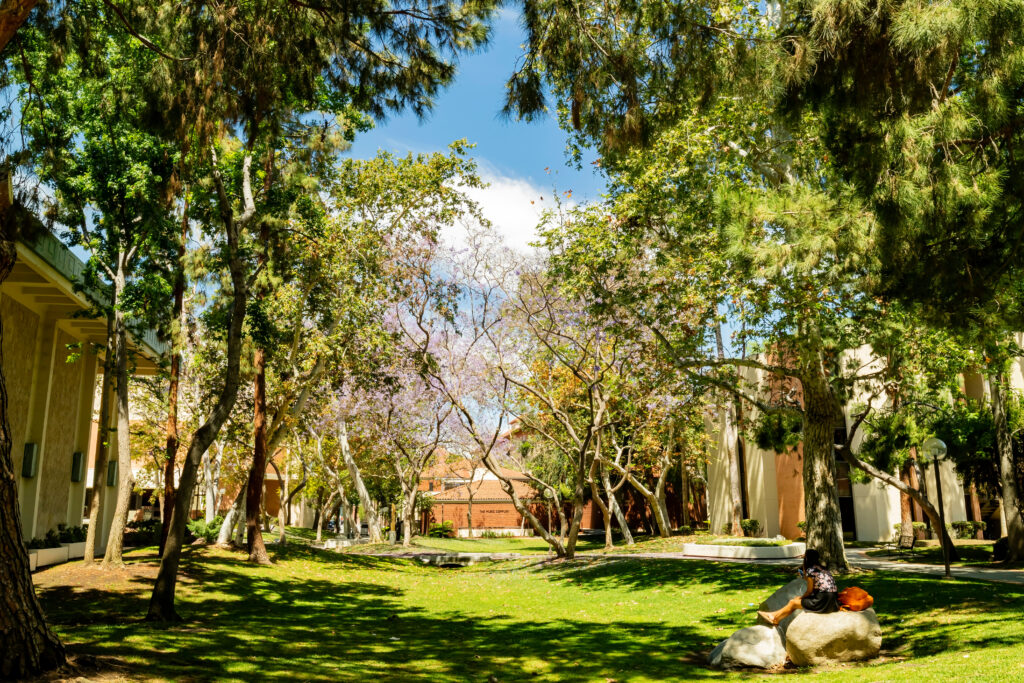The University of Southern California (USC) is a globally-renowned private college located in the heart of Los Angeles. Offering vibrant campus life and strong connections to the entertainment and tech industries, it’s not hard to see why USC attracts thousands of talented applicants each year. In contrast to the easy-going atmosphere of campus, however, the university’s competitive acceptance rate means that gaining admission is far more challenging.
This guide will explore the latest USC acceptance rate trends, dissect what makes a successful student, and offer strategies to boost your chances. You’ll also learn why you may see two different admit rates reported for 2029 (fall-only vs. overall), and how to read them correctly.
Have your eyes on a spot at USC? Let’s learn about the newest Trojans, the Class of 2029!
About the University of Southern California
First, here are quick facts about USC to get your bearings.
- School system: Undergrad study is based at the main University Park campus (Los Angeles). The Health Sciences Campus is for graduate and professional studies only.
- Application timing:
- Early Decision (binding; business school only): Nov 1.
- Early Action (non-binding; most majors) + merit scholarship consideration: Nov 1.
- Regular Decision (portfolio/audition majors): Dec 1.
- Regular Decision (most majors): Jan 10.
- Testing: USC is currently test-optional through the 2025-2026 academic year.
- Essays: Applicants are required to submit several short essays as part of the USC application.
- Honors: USC offers a variety of honors programs for students.
If you aren’t already sold on the mild West Coast weather and palm-tree-lined campus, then take a look for yourself:
USC acceptance rate trends (and what they mean)
What’s the difference between fall-only and overall?
USC offers spring admission to some applicants. The fall-only admit rate reflects the most selective pool, while the overall admit rate includes spring offers, increasing the acceptance percentage slightly. If you see different numbers online, this is why.
According to the USC Admissions website, the university’s overall acceptance rate has remained highly competitive in recent years:
- Class of 2025: ~12%.
- Class of 2026: ~11–12%.
- Class of 2027: 9.9%.
- Class of 2028: 9.2%.
- Class of 2029: 11.2%.
Not to mention, applicants targeting the university’s most popular and competitive programs (such as Computer Science) can expect even lower acceptance rates. Programs like Viterbi (Engineering), Marshall (Business), and SCA (Cinematic Arts) are also among the most selective.
Actionable takeaways:
- Apply Early Action by the November 1st deadline to be considered in the strongest applicant pool.
- Develop a well-rounded profile that showcases academic achievements, extracurricular involvement, and unique personal qualities. For artists (applying to SCA, Kaufman, Thornton, and Roski), plan ahead; portfolios and auditions are not just extras, they’re central to admissions. Polish your work and label files clearly.
- Carefully craft the USC-specific essays to demonstrate your fit with the university’s academic and community offerings.
Average accepted student profile at USC
USC’s official 2025–26 profile (covering the Class of 2029) reports the following middle-50% ranges:
- Unweighted GPA (4.00 scale): 3.87–4.00
- SAT (super-scored): 1490–1550
- ACT (super-scored): 33–35
- Score submitters: 44% of enrolled submitted SAT/ACT
- Entering class: 3,759 | Merit scholars: 546 | First-gen: 21%
These figures demonstrate the increasingly selective nature of USC’s admissions process.

Building a profile that stands out at USC
USC conducts a holistic review, weighing academic preparation, intellectual curiosity, character, impact, and context.
To increase your chances of admission, focus on the following key areas.
Academics:
Take the most rigorous courses you can succeed in, especially if they correspond with your intended major. Your transcript should show progression and consistency. (Check each school’s prep guidance before you claim specific prerequisites.)
Standardized testing:
USC remains test-optional, and a majority of enrollees did not submit scores last cycle. If your results land within or above the enrolled middle-50% (roughly 1470–1540 SAT or 32–35 ACT), sending them can reinforce academic readiness. Otherwise, focus on rigor, grades, and the story your activities and essays tell.
Extracurricular involvement:
Impact over volume. Highlight outcomes: a launched app, a published film, league leadership, a nonprofit initiative, or measurable community change. For arts, strong portfolios and audition preparation are decisive; for research, name mentors, methods, and outputs (poster, paper, competition).
Essays:
Be specific to signal your fit. Avoid generic LA or “dream school” tropes. Instead, connect your goals to specific USC resources (e.g., a Viterbi lab or institute, Marshall’s case competitions, The Garage at IYA, the Trojan Marching Band, or Annenberg media outlets) and explain how you’ll use them.
Recommendations:
It’s all about context and character. Choose teachers who can describe how you think, not just how you scored. A counselor can explain context (course access, family responsibilities, school changes).

Life in cardinal and gold
USC runs on a semester calendar in an urban L.A. setting. So what can you expect? A mix of large lectures and smaller discussions or labs, meaningful time commitments outside class, and the possibility of in-semester internships. Let’s break it down.
Academics at USC:
Classes follow a semester rhythm, with many introductory courses held in larger lecture halls and upper-division seminars tending to be smaller. Crossing schools is common (double majors and minors happen across Dornsife, Viterbi, Marshall, Annenberg, SCA, and more) but you’ll need to plan around registration priorities. Research and creative projects are accessible through labs, studios, and faculty teams if you pitch yourself early and show basic skills.
Community:
Student life is active, with more than 800 organizations that usually meet weekly and often require officer hours or rehearsal/build time. Most first-years live on campus, including at USC Village, and many students move to nearby apartments after their first year. Meal plans are required in most on-campus housing, so it’s smart to watch change deadlines and pick a plan that fits your routine. Getting around typically combines the Metro U-Pass for buses and rail with walking, scooters, and rideshare. For safety, learn DPS boundaries, late-night transport options, the alert system, and blue-light locations.
Outcomes for alumni:
Due to the location, internships during the semester are common across various fields, including media, technology, health, and consulting. Most students utilize Handshake and school-specific portals to find these roles. If you’re aiming for an internship, register early for career fairs, follow faculty research labs, and tap into the USC Career Center’s Industry Insight panels. Start building your network now.
Your next steps to college
If you’re interested in building a comprehensive USC is selective, but the path is knowable: understand fall-only vs. overall admit rates, pick the right application plan, match your prep to your intended school, and use essays to show how you’ll plug into USC’s resources. Submit scores only if they help. Build a realistic weekly plan for classes, clubs, and early internships. Keep your eye on the goal!
If you want support turning this outline into a compelling application, we can map your major/school fit, set a test-optional plan, and pressure-test your USC essays and activity descriptions against what readers actually look for. Book a consultation discussion today! We’ll start with your deadlines and work backward. Your future awaits.
